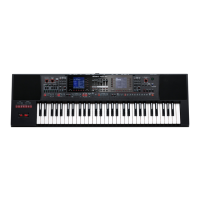15
User Program Edit Parameters
Switch o the [SPLIT] button if the Arranger should scan the entire
keyboard (“Whole”).
The range of the left and right keyboard areas depends on the “Split
Point” setting (Owner’s Manual: p. 18).
Parameter Value
Zone O, Left, Right, Whole
Type
Another important choice is how you want to transmit note
information to the Arranger.
Parameter value
Type Standard, Pianist1, Pianist2, Intelligent, Easy
NOTE
If the “Arr Type” parameter (p. 8) is set to “O n ,” this “Type”
setting has no eect.
Standard: This is the normal chord recognition mode.
Pianist1: In this mode, the E-A7 only recognizes chords that consist
of at least three notes. Playing only two notes will not cause
the style’s key to change.
Pianist2: Same as “Pianist1” while the Hold pedal is not pressed.
If you press the Hold pedal, the E-A7 even recognizes
“chords” when you press only one note. If the hold pedal is
still pressed, chord recognition continues up to a maximum
of 5 played keys.
Intelligent: Select this option when you want the chord recognition
function to supply the missing notes of the chords you play.
Easy: This is another “intelligent” chord ngering system.
It works as follows:
Major chords
Press the key that corresponds to the chord’s funda-
mental.
Minor chords
Fundamental + any black key to the left of the
fundamental.
Seventh chords
Fundamental + any white key to the left of the
fundamental.
Minor seventh chords
Fundamental + any black key to the left + any white
key to the left.
Arranger Hold
This function sustains the notes you play in the chord recognition
area (“Zone”). Select “O” if you want the accompaniment to
stop as soon as the keys in that zone are released. This parameter is
switched “On” by default.
Parameter Value
Arranger Hold O, On
Fill In Half Bar
When this parameter is “O n ,” the length of the Fill-Ins, which are
played when the [AUTO FILL IN] button lights, is halved.
Parameter Value
Fill In Half Bar O, On
Certain pop songs in 4/4 contain bars that only last two beats. The
usual place for such a bar is between the rst and the second verse.
Another favorite position for “halved” bars is at the end of a chorus
or the bridge. Your E-A7 allows you to faithfully reproduce these
“anomalies” using this function. This does not change style playback
right away. Only when a ll-in or another VARIATION pattern starts
will the “Fill-in Half Bar” function be activated and play half the
number of beats of the accompaniment pattern you selected.
Fill Rit. (Fill Ritardando)
The FILL RIT function is suitable for ballads. It causes the next Fill-In
to slow down (“ritardando”). See “Tempo Change Fill Rit” below
for how to set how strongly the tempo should be decreased.
Parameter Value
Fill Rit. O, On
As the name implies, it is only available while the [AUTO FILL-IN]
button lights.
a. Set “Fill Rit.” to “ O n .”
b. Start Arranger playback.
c. Press a VARIATION [1]–[4] button.
The E-A7 plays a Fill-In. The tempo slows down while the ll is
being played. At the end of the ll, return to the original tempo.
Tempo Change Accel/Ritard, CPT, Fill Rit
The “T. Ch. Acc/Rit” (Tempo Change Acceler/Ritard) parameter
allows you to speed up or slow down the style tempo by the amount
you set here. To use these functions, you must assign them to an
optional footswitch (p. 21).
There are three Ritardando functions: one for all style patterns, one
for Ending patterns and one for ll-ins (see “Fill Rit.” above). They all
use the “Tempo Change” settings on the following page.
Parameter Value
T. Ch. Acc/Rit 5%–92%
T. Ch. CPT 0–3825
T. Ch. FillRit 5%–92%
T. Ch. Acc/Rit (Tempo Change Accel/Ritard): Allows you to set the
degree (ratio) by which the tempo changes when the “Acceler” or
“Ritard” function is triggered. Example: if the tempo is currently
¸
=
100, the value “20%” means that the tempo drops to
¸
= 80 or rises
to
¸
= 120.
T. Ch. CPT (Tempo Change CPT): Use this parameter to specify how
long a ritardando/accelerando should take. In most cases, 480 CPT
(i.e. one measure) is probably the most musical choice.
T. Ch. FillRit (Tempo Change Fill Rit): This parameter allows you to
specify to what extent ll-in playback should be slowed down when
the “Fill Ritardando” function is on.
9 Using the Ritardando/Accelerando functions
For general applications (any style division) proceed as follows:
5 Assign the “Arr Rit” or “Arr Acc” function to an optional
footswitch (p. 21).
5 Press the [START/STOP] button to start style playback.
5 Press the assigned footswitch.

